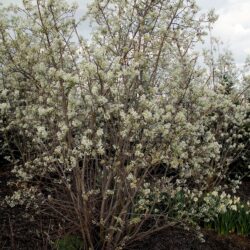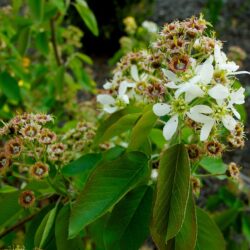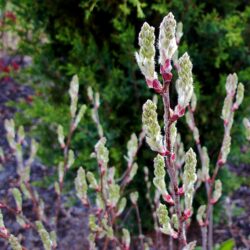Etymology
Amelanchier is likely derived from the Provençal name of the European Amelanchier ovalis. The word spicata comes from New Latin and means “spiked”.
Native Habitat
Woodland, Forest Edge, Prairie, Meadow, Rocky Bluff.
Garden Uses
Best in shrub borders, woodlands, or native plant gardens. Also effective along stream banks and ponds. The plant's small size lends itself well to growing in rock gardens. It is useful as a hedge planting because of its tendency to spread.
Overview
Running Serviceberry is a multi-season plant that is attractive to bees, other pollinators, and birds. It forms dense, low thickets through the production of many upright shoots from the underground stems. They are easily grown in average, medium, well-drained soil in full sun to part shade. Tolerant of a somewhat wide range of soils.
Leaves and Stems
Alternate, oval to almost circular, medium to dark green leaves are 1 to 3 inches long, with smooth margins and fine serrations on the upper 2/3 of the leaf margins. Blue-green leaf color changes to variable shades of yellow, orange, and red in autumn. Young stems have ashy-gray bark with faint stripes. The reddish-brown twigs are slender and flexible. The bark of an adult plant is thin and smooth.
Flowers
Showy, five-petaled white flowers in drooping clusters appear before the leaves emerge in early spring.
Fruit/Seed
Small, round, green berries mature to a dark purplish-black in summer. Each berry contains 4 to 10 seeds.
Wildlife Associates
Running Serviceberry is a host plant for 105 species of Lepidoptera larvae, including the Eastern Tiger Swallow Tail (Papilio glaucus), Red Spotted Purple (Leminitis arthemis), Interrupted dagger moth (Acronicta interrupta), Pale Beauty Moth (Campaea perlata), admiral butterflies, and two specialist moths. Bees are attracted to the flowers, and fruits are eaten by songbirds, ruffed grouse, and a wide range of mammals. It’s mildly resistant to deer.
Propagation
Amelanchier spicata can be propagated from rooted suckers, root cuttings, and seeds.
Ethnobotanical Uses
Edible berries are often used in pies. The plant has been used medicinally to support digestive and reproductive systems. A tea made from the roots was used to treat excessive menstrual bleeding and diarrhea. The inner bark was used as a disinfectant wash for eyes. Native Americans mashed and dried the fruits into cakes or mixed the dried fruits with meat and fat to form pemmican for long winter travels.
Garden Location
Teaching Garden (see garden map)
Sources
Morton Arboretum
Missouri botanical Garden
Leaves for Wildlife
Plant Profile by Kathy Kling



